
| Home | Deepsky Atlas | TheAstronews | Links | Solar System | ||||||

Hawaiian Astronomical SocietyConstellations: Cygnus -- Zeus on the Prowl, or a True Friend? |
||||||||||
Zeus knew from past experience that a disguise would work better to approach her. He disguised himself as a beautiful white swan and flew over to her. Leda noticed the beautiful swan, and played with it, not knowing it was Zeus. Even though Zeus was still in disguise, he had his way with her. Leda became pregnant and laid two eggs. One egg hatched Pollux and Helen, immortal because they were the offspring of Zeus. The other egg hatched the mortals Castor and Clytemnestra; they were the offsprings of Tyndareus. Of course, Pollux and Castor are known as the Heavenly Twins.
The second story is also associated with Eridanus, the River story, so I will not go too deeply into the story. A young man named Phaethon (the son of sun god Helios) was driving his father's fiery chariot across the heavenly sky. He lost control of the chariot and started burning everything in sight. Zeus didn't want him to damage the earth any further. He threw a strong thunderbolt at the chariot. Phaethon and the chariot fell in the Eridanus. One of his best friends searched for his scorched body in the water for so long that he eventually became a swan.
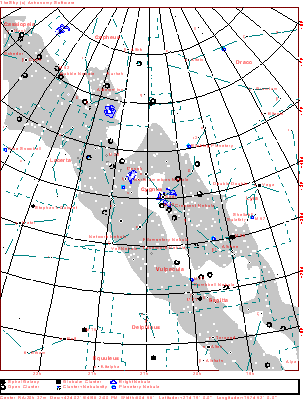
Click the map for a 909x1199 version of the above. Click here for a map better suited for use in the field.
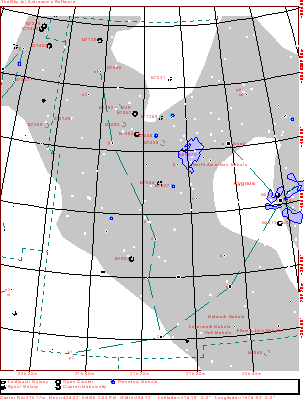
This a more detailed view of the constellation. The map displays stars to magnitude 10, and deepsky objects to magnitude 12. Click here for a map better suited for use in the field.

Click here for a map better suited for use in the field.
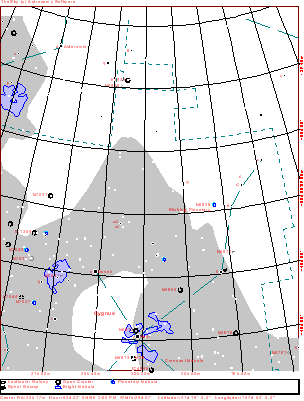
Click here for a map better suited for use in the field.
|
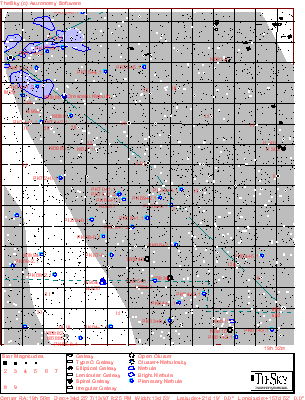 66k GIF The Cygnus Star Cloud is a portion of the Milky Way that stretches from Sadr (Gamma Cygni) to Albireo (Beta Cygni). The Milky Way divides south of Deneb (Alpha Cygni) and continues south to Ophiuchus. The Cygnus Star Cloud resides in the western portion of this division. This "image" is a detailed map of the region, very much worth sweeping at low power. Click here for a map better suited for use in the field. 66k GIF The Cygnus Star Cloud is a portion of the Milky Way that stretches from Sadr (Gamma Cygni) to Albireo (Beta Cygni). The Milky Way divides south of Deneb (Alpha Cygni) and continues south to Ophiuchus. The Cygnus Star Cloud resides in the western portion of this division. This "image" is a detailed map of the region, very much worth sweeping at low power. Click here for a map better suited for use in the field.
|
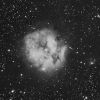 86k JPEG IC5146 (Caldwell 19) is also called the Cocoon Nebula. You find it in the far NE of Cygnus near Lacerta. Dreyer calls it faint (mag. 7), large (9'), and sort of round. A mag. 9.5 star sits in the center, and the whole area is shot through with light and dark areas. Some observers report an H-beta filter works well. From the Digital Sky Survey. 86k JPEG IC5146 (Caldwell 19) is also called the Cocoon Nebula. You find it in the far NE of Cygnus near Lacerta. Dreyer calls it faint (mag. 7), large (9'), and sort of round. A mag. 9.5 star sits in the center, and the whole area is shot through with light and dark areas. Some observers report an H-beta filter works well. From the Digital Sky Survey.
|
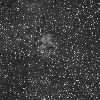 100k JPEG A nice star field in Cygnus showing 100 stars in a one degree area, somewhat separated from the surrounding stars. Located 1.25° SSW of Pi-1 Cygni. The above is based on Jeff Bondono's observations with an 8" Newtonian in moderate suburban light pollution. Nebulosity in the Digital Sky Survey photo was not visible. 100k JPEG A nice star field in Cygnus showing 100 stars in a one degree area, somewhat separated from the surrounding stars. Located 1.25° SSW of Pi-1 Cygni. The above is based on Jeff Bondono's observations with an 8" Newtonian in moderate suburban light pollution. Nebulosity in the Digital Sky Survey photo was not visible.
|
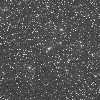 82k JPEG M39 (NGC7092) is located 9.2° ENE of Deneb (Alpha Cygni). At mag. 4.6, this open cluster consists of a number of bright stars scattered over a 32' field. Like M29, the "field" is also the Milky Way. Dreyer adds that this is a poor cluster of mag. 7-10 stars. "Poor" means few stars for the area; it does not mean to avoid it. From the Digital Sky Survey. 82k JPEG M39 (NGC7092) is located 9.2° ENE of Deneb (Alpha Cygni). At mag. 4.6, this open cluster consists of a number of bright stars scattered over a 32' field. Like M29, the "field" is also the Milky Way. Dreyer adds that this is a poor cluster of mag. 7-10 stars. "Poor" means few stars for the area; it does not mean to avoid it. From the Digital Sky Survey.
|
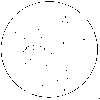 2k GIF A description of NGC7082 by Jere Kahanpää from observations through an 8" Newtonian: A clear but scattered cluster of stars in the western part of the field. The stars seem to be of two separate classes: there are about half a dozen bright stars (about mag.10) and a rich background of clearly fainter ones (mag. 12...) A nice effect. 2k GIF A description of NGC7082 by Jere Kahanpää from observations through an 8" Newtonian: A clear but scattered cluster of stars in the western part of the field. The stars seem to be of two separate classes: there are about half a dozen bright stars (about mag.10) and a rich background of clearly fainter ones (mag. 12...) A nice effect.
Dreyer calls it large (25'), quite rich, little condensed, with stars from mags. 10-13. You find it .7° NW of Rho Cygni. Image is a drawing by Jere Kahanpää.
|
|
 145k GIF Click here for a 1033x1309 JPEG image (424k). This is a Hubble image of NGC7027 (Best 47), a mag. 10 planetary nebula 3° SSE of the North America Nebula. Described has having a stellar center estimated at mag. 8.5. Its size is 20". The central star appears bluish, or lime green. The description of the photo follows. 145k GIF Click here for a 1033x1309 JPEG image (424k). This is a Hubble image of NGC7027 (Best 47), a mag. 10 planetary nebula 3° SSE of the North America Nebula. Described has having a stellar center estimated at mag. 8.5. Its size is 20". The central star appears bluish, or lime green. The description of the photo follows.
"This NASA Hubble Space Telescope image of planetary nebula NGC 7027 shows remarkable new details of the process by which a star like the Sun dies. The photograph is a composite of two Hubble images, taken in visible and infrared light, and is shown in "pseudo-color."
"Credit: H. Bond (STScI) and NASA"
|
 77k JPEG NGC7000 (Best 46, Caldwell 20) is an extremely (Dreyer uses "extremely" twice) large (roughly 2°), faint (integrated magnitudes do not mean much at this size) nebula located 3.2° east of Deneb (alpha Cygni). Difficult in most scopes, it comes alive in an 11x80 finder with an OIII filter. 77k JPEG NGC7000 (Best 46, Caldwell 20) is an extremely (Dreyer uses "extremely" twice) large (roughly 2°), faint (integrated magnitudes do not mean much at this size) nebula located 3.2° east of Deneb (alpha Cygni). Difficult in most scopes, it comes alive in an 11x80 finder with an OIII filter.
Photographer's notes: North America Nebula with the Pelican Nebula, 2 hrs hypered 4x5 inch Technical Pan (4415) ... Photo by Brad D Wallis (copyrighted) using a special 4x5 inch film back designed by BDW for the 6-inch f/7.5 A-P EDF refractor... A-P is now offering such a camera derived from the BDW design... The entire 4-inch diameter circle at the focal plane of the EDF is usable with this 4x5 inch back... an enlargement from a portion of this image can be seen in PELICAN.JPG and other images from this setup can be found here.
|
 45k JPEG Detail from the above photo (318x534). 45k JPEG Detail from the above photo (318x534).
|
 104k JPEG Dolidze 36 is an open cluster located 4.2° WNW of Sadr (Gamma Cygni). Frankly, it's not too exciting; it stands out poorly from a rich Milky Way. An interesting S shaped asterism of stars lies just north of the cluster. A line of six stars (PA105) runs through the cluster. The cluster itself contains about 30 mag. 12 stars. Image from the Digital Sky Survey with the cluster and asterism marked. 104k JPEG Dolidze 36 is an open cluster located 4.2° WNW of Sadr (Gamma Cygni). Frankly, it's not too exciting; it stands out poorly from a rich Milky Way. An interesting S shaped asterism of stars lies just north of the cluster. A line of six stars (PA105) runs through the cluster. The cluster itself contains about 30 mag. 12 stars. Image from the Digital Sky Survey with the cluster and asterism marked.
|
 75k JPEG NGCs 6992, 6995, and 6960 (Best 45 & 44, Caldwell 33 & 34) make up the eastern and western areas of the Veil Nebula, a supernova remnant in Cygnus. Traveling 3.3° south of epsilon Cygni, you come to 52 Cygni, which sits in the center of the western Veil. The Eastern Veil sits 2.5° WNW. Both areas have "extremely" applied to "faint," "large," and "elongated." An OIII filter at about 6 power per inch of aperture transforms the object. It looks great in a 15x80mm spotting scope; the entire nebula is visible. A 6" easily will bring out the filamentary structure. A 12" produces awe inspiring views. This image is a mosaic of about 25 meg. of downloads from the Digital Sky Survey. 75k JPEG NGCs 6992, 6995, and 6960 (Best 45 & 44, Caldwell 33 & 34) make up the eastern and western areas of the Veil Nebula, a supernova remnant in Cygnus. Traveling 3.3° south of epsilon Cygni, you come to 52 Cygni, which sits in the center of the western Veil. The Eastern Veil sits 2.5° WNW. Both areas have "extremely" applied to "faint," "large," and "elongated." An OIII filter at about 6 power per inch of aperture transforms the object. It looks great in a 15x80mm spotting scope; the entire nebula is visible. A 6" easily will bring out the filamentary structure. A 12" produces awe inspiring views. This image is a mosaic of about 25 meg. of downloads from the Digital Sky Survey.
|
The original descr. from W. Herschel: "A star 6 m ... not in the middle but following. Surrounded by many cst. forming a brilliant sc. Cl." The mag. 6 star W.H. mentions is near the NE edge of the field (and is the brightest star in the photograph).
The field includes at least 2 candidates:
B) A bit brighter but not as well detached group of stars 10' NW of the first one. Includes 20 stars mag. 9...11. Tr-type IV 2 p. This group is visible in the drawing as a slight concentration of bright stars in the NW quarter. Position 20h 54.4m +47° 26.7'(2000)
The photograph is from the Digital Sky Survey. The associated nebulosity (IC5076) is not easily visible, even with UHC filters. The sketch is by Jere Kahanpää.
|
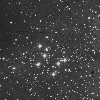 74k JPEG M29 (NGC6913) is located 1.8° south of Sadr (Gamma Cygni). At mag. 6.6, this open cluster is consists of relatively few, bright stars scattered over a 7' field. Since the "field" happens to be the Milky Way, the effect is quite pretty. From the Digital Sky Survey. 74k JPEG M29 (NGC6913) is located 1.8° south of Sadr (Gamma Cygni). At mag. 6.6, this open cluster is consists of relatively few, bright stars scattered over a 7' field. Since the "field" happens to be the Milky Way, the effect is quite pretty. From the Digital Sky Survey.
|
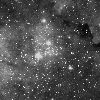 62k JPEG NGC6910 is sometimes called the Y Cluster. You find it .6° ENE of Sadr (Gamma Cyg). Dreyer calls it fairly bright (7.4), fairly small (8'), poor, and fairly condensed. Later estimates raise the number of stars from 20 to 50 at mag. 9.6 and fainter. Faint nebulosity throughout a gorgeous field. A low power eyepiece can include Sadr with the cluster. Image from Le super NGC Catalogue! Image looks like it came from the Digital Sky Survey. 62k JPEG NGC6910 is sometimes called the Y Cluster. You find it .6° ENE of Sadr (Gamma Cyg). Dreyer calls it fairly bright (7.4), fairly small (8'), poor, and fairly condensed. Later estimates raise the number of stars from 20 to 50 at mag. 9.6 and fainter. Faint nebulosity throughout a gorgeous field. A low power eyepiece can include Sadr with the cluster. Image from Le super NGC Catalogue! Image looks like it came from the Digital Sky Survey.
|
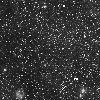 108k JPEG IC4996 is a pretty open cluster located 2.8° SSW of Sadr (Gamma Cygni). It contains 15 stars, several of contrasting colors, from mags. 8-13 over a 6' area, all embedded in a rich field. Sitting .7° south is Dolidze 3, a cluster of 40 stars in a 15 minute area, surrounded by an small empty area, and then embedded in the Cygnus Star Cloud. Labeled image from the Digital Sky Survey. 108k JPEG IC4996 is a pretty open cluster located 2.8° SSW of Sadr (Gamma Cygni). It contains 15 stars, several of contrasting colors, from mags. 8-13 over a 6' area, all embedded in a rich field. Sitting .7° south is Dolidze 3, a cluster of 40 stars in a 15 minute area, surrounded by an small empty area, and then embedded in the Cygnus Star Cloud. Labeled image from the Digital Sky Survey.
|
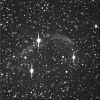 66k JPEG NGC6888 (Caldwell 27) is sometimes called the Crescent Nebula. It is 2.7° SW of Gamma (Sadr). About 20' long, Dreyer calls it faint, very large (20'x10') and very elongated. 66k JPEG NGC6888 (Caldwell 27) is sometimes called the Crescent Nebula. It is 2.7° SW of Gamma (Sadr). About 20' long, Dreyer calls it faint, very large (20'x10') and very elongated.
|
 105k JPEG NGC6883 is an open cluster located 3.1° ENE of Eta Cygni. You find it in the upper, left of the picture. Dreyer describes this mag. 8 cluster as fairly rich (30 stars), with a double star involved. NGC6883 sits in a nice field that includes the fainter cluster Biurakan 2 (30' to the lower right, or southwest). This mag. 6.4 cluster contains ten stars of mag. 7.9 and fainter. The field is better than the cluster. Labeled image from the Digital Sky Survey. 105k JPEG NGC6883 is an open cluster located 3.1° ENE of Eta Cygni. You find it in the upper, left of the picture. Dreyer describes this mag. 8 cluster as fairly rich (30 stars), with a double star involved. NGC6883 sits in a nice field that includes the fainter cluster Biurakan 2 (30' to the lower right, or southwest). This mag. 6.4 cluster contains ten stars of mag. 7.9 and fainter. The field is better than the cluster. Labeled image from the Digital Sky Survey.
|
|
 59k JPEG NGC6826 (Best 43, Caldwell 15) is a planetary nebula called the Blinking Planetary. Located 1.3° ENE of theta Cygni, you find it in the lower, left of the picture. Dreyer describes it as bright (mag. 10), pretty large (2.3'), round, and with a mag. 11 central star. Stare at the central star directly, and it may "blink" out. The mag. 15.8 galaxy CGCG257-9 sits at the upper right of the photo. The mag. 14.4 galaxy CGCG257-10 lies in the lower, right. 59k JPEG NGC6826 (Best 43, Caldwell 15) is a planetary nebula called the Blinking Planetary. Located 1.3° ENE of theta Cygni, you find it in the lower, left of the picture. Dreyer describes it as bright (mag. 10), pretty large (2.3'), round, and with a mag. 11 central star. Stare at the central star directly, and it may "blink" out. The mag. 15.8 galaxy CGCG257-9 sits at the upper right of the photo. The mag. 14.4 galaxy CGCG257-10 lies in the lower, right.
|
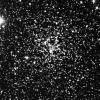 71k JPEG NGC6819 (Best 42) is a mag. 7.3 open cluster lying 7.8° west of Sadr (Gamma Cygni). Dreyer describes it as very large (5'), and very rich in stars. It packs in close to 100 stars of magnitude 11 to 15. 71k JPEG NGC6819 (Best 42) is a mag. 7.3 open cluster lying 7.8° west of Sadr (Gamma Cygni). Dreyer describes it as very large (5'), and very rich in stars. It packs in close to 100 stars of magnitude 11 to 15.
|
If you have any questions about the Hawaiian Astronomical Society
please
(link requires javascript).